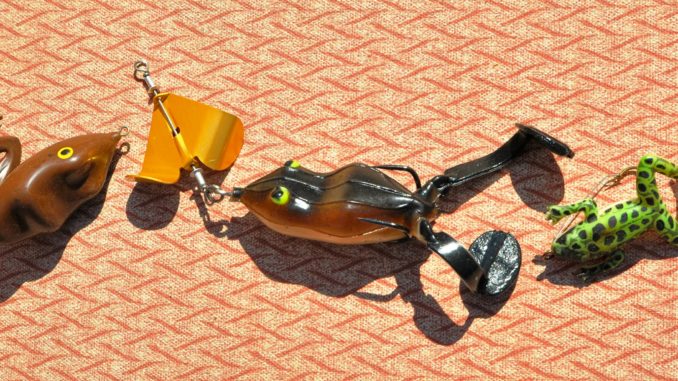
Fake hoppers can be great bass baits on lakes with surface vegetation
During hot weather, largemouths at many large lakes head to deep water for comfort and baitfish, and anglers who chase them have sporadic success. But shoreline vegetation sprouts this time of year and affords opportunities for faster action, especially for anglers who cast soft-plastic frog lures at weed-covered shallow water and are patient enough to set hooks after a bass’s heart-throbbing surface attack.
Some of the year’s largest bass are caught during late May through August in ponds, especially at early morning and late evening hours. That’s when frogs are most active. Also, during June and July, many frogs are small, and bass will whack fake frogs with a vengeance.
Bigger lakes with coves containing surface vegetation can be great places to use frog lures, especially during early morning, late-evening and after-dark hours.
Most frog baits are designed to be weedless, with hooks upturned along the sides, but anglers fishing frogs should be prepared for hang-ups and removing grass from lures.
At least 40-pound braided line with a heavier leader and heavy tackle is recommended to pull bass from the weeds, and some anglers use stronger line. A baitcasting reel with a 4-to-1 retrieve ratio works well because you don’t fish frogs quickly. Pauses and stops seem to create more strikes, especially when an artificial frog finds an opening in a weed bed.
Some current favorite frog imitators include the Spro Bronzeye, Booyah Poppin’ Pad Crusher, Heddon Moss Boss, Mann’s Swimmin’ Frog, Strike King Bass Frog Jr., Norman Weed Walker, Koppers Live Target Walking Frog, Southern Livetarget Hollow Frog and Snag Proof Bobby’s Perfect Buzz Frog.
The Snag Proof Bobby’s Buzz Frog has a buzzbait blade attached at the front of the lure’s body to create more commotion and help cut a path through weeds.
Frog lure colors usually include shades of green, yellow or brown.
Angler reactions to surface strikes require patience, because most bass streak from the bottom and blow up on frogs, often missing the hook. An angler who waits a second or two to feel the weight of the fish before he snaps the rod tip skyward will get more and better hook-ups. A quick reaction to a bass’s topwater attack will more often than not will yank the lure out of the fish’s mouth.
An idea, too, when that happens, is to cast the frog at the spot where the bass missed the initial strike and twitch it one or two times.
Fishing at night with frogs in aquatic vegetation is a good tactic and may draw dozens of reaction strikes. In the heat of summer, night-fishing also usually is more comfortable.




Be the first to comment